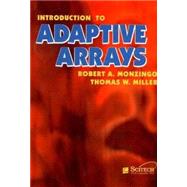
| Adaptive Array Fundamental Principles: System Uses, System Elements, Basic Concepts, and Optimum Array Processing | |
| Introduction | p. 3 |
| Motivation for Using Adaptive Arrays | p. 3 |
| Historical Perspective | p. 5 |
| Principal System Elements | p. 6 |
| Adaptive Array Problem Statement | p. 8 |
| Existing Technology | p. 11 |
| Organization of the Book | p. 21 |
| Summary and Conclusions | p. 23 |
| Adaptive Array Concept | p. 29 |
| Signal Environment | p. 30 |
| Array Element Spacing Considerations | p. 34 |
| Array Performance | p. 47 |
| Nulling Limitations Due to Miscellaneous Array Effects | p. 56 |
| Narrowband and Broadband Signal Processing Considerations | p. 60 |
| Summary and Conclusions | p. 64 |
| Optimum Array Processing: Steady-State Performance Limits and the Wiener Solution | p. 78 |
| Mathematical Preliminaries | p. 80 |
| Signal Descriptions for Conventional and Signal Aligned Arrays | p. 87 |
| Optimum Array Processing for Narrowband Applications | p. 89 |
| Optimum Array Processing for Broadband Applications | p. 105 |
| Optimum Array Processing for Perturbed Propagation Conditions | p. 128 |
| Summary and Conclusions | p. 131 |
| Adaptive Algorithms | |
| Gradient-Based Algorithms | p. 155 |
| Introductory Concepts | p. 156 |
| The Least Mean Square Error (LMS) Algorithm | p. 162 |
| The Differential Steepest Descent (DSD) Algorithm | p. 178 |
| The Accelerated Gradient Approach | p. 188 |
| Gradient Algorithm with Constraints | p. 192 |
| Simulation Results | p. 207 |
| Summary and Conclusions | p. 211 |
| The Howells-Applebaum Adaptive Processor | p. 217 |
| Introductory Concepts | p. 217 |
| Two-Element Array with One Adaptive Loop | p. 223 |
| N-element Array with N Adaptive Loops | p. 245 |
| Introduction of Main Beam Constraints | p. 273 |
| Constraint for the Case of Known Desired Signal Power Level | p. 283 |
| Summary and Conclusions | p. 287 |
| Direct Inversion of the Sample Covariance Matrix | p. 293 |
| The Direct Matrix Inversion (DMI) Approach | p. 293 |
| Transient Response Comparisons | p. 307 |
| Sensitivity to Eigenvalue Spread | p. 312 |
| Summary and Conclusions | p. 313 |
| Recursive Methods for Adaptive Array Processing | p. 319 |
| The Weighted Least-Squares Error Processor | p. 319 |
| Updated Covariance Matrix Inverse | p. 324 |
| Kalman Filter Methods for Adaptive Array Processing | p. 326 |
| The Minimum Variance Processor | p. 334 |
| Simulation Results | p. 339 |
| Summary and Conclusions | p. 344 |
| Cascade Preprocessors | p. 348 |
| Nolen Network Preprocessor | p. 349 |
| Interference Cancellation with a Nolen Network Preprocessor | p. 358 |
| Gram-Schmidt Orthogonalization Preprocessor | p. 364 |
| Simulation Results | p. 376 |
| Summary and Conclusions | p. 382 |
| Random Search Algorithms | p. 390 |
| Linear Random Search (LRS) | p. 391 |
| Accelerated Random Search (ARS) | p. 398 |
| Guided Accelerated Random Search (GARS) | p. 401 |
| Simulation Results | p. 405 |
| Summary and Conclusions | p. 410 |
| Adaptive Algorithm Performance Summary | p. 418 |
| Adaptive Array Compensation and Current Research Trends | |
| Compensation of Adaptive Arrays | p. 429 |
| Broadband Signal Processing Considerations | p. 429 |
| Multipath Compensation | p. 451 |
| Analysis of Interchannel Mismatch Effects | p. 461 |
| Summary and Conclusions | p. 475 |
| Current Trends in Adaptive Array Research | p. 481 |
| The Maximum Entropy Method (MEM) for Spectral Estimation | p. 481 |
| Sequential Implementation of Bayes Optimal Array Processor | p. 493 |
| Partially Adaptive Array Concepts | p. 498 |
| Summary and Conclusions | p. 506 |
| Frequency Response Characteristics of Tapped-Delay Lines | p. 516 |
| Complex Envelope Notation | p. 521 |
| Convenient Formulas for Gradient Operations | p. 525 |
| Useful Matrix Relations and the Schwartz Inequality | p. 527 |
| Multivariate Gaussian Distributions | p. 530 |
| Geometric Aspects of Complex Vector Relationships | p. 537 |
| Index | p. 539 |
| Table of Contents provided by Ingram. All Rights Reserved. |
The New copy of this book will include any supplemental materials advertised. Please check the title of the book to determine if it should include any access cards, study guides, lab manuals, CDs, etc.
The Used, Rental and eBook copies of this book are not guaranteed to include any supplemental materials. Typically, only the book itself is included. This is true even if the title states it includes any access cards, study guides, lab manuals, CDs, etc.